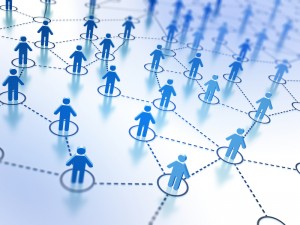How Many Friends Can You Have?

No point in making it bigger.
Three years ago, I wrote an article about Dunbar’s number and how it affects my business. To recap briefly, Robin Dunbar is a British anthropologist who studies primates and their social circles. He noted an interesting correlation – monkeys with small neocortexes (relative to the rest of the brain) also had small social circles. Monkeys with larger neocortexes had larger social circles. These findings became the basis of the social brain hypothesis – that our brains put an upper limit on our social relationships.
Dunbar plotted the correlation – it moved up and to the right on a two-dimensional chart – and projected it to larger primates known as humans. Dunbar’s data suggest that the “natural” upper limit for human social circles is around 150 people.
That correlates roughly with my consulting experience. Many of my clients are small software companies that call me when they reach approximately 150 employees. They’re experiencing growing pains and they need some help. I’m happy to oblige.
The data suggest that our brain capacity – and especially our ability to think abstractly – somehow limits the size of the social circles we can maintain. But what if there’s a simpler explanation? As we know, simpler explanations are usually better.
What if the cause is simply the time it takes to maintain relationships? It takes time and effort to maintain a relationship and keep it active. What if we could use advanced technologies to reduce the “time cost of servicing a relationship”? Would that allow us to expand our relationships and maintain larger social networks?
Professor Dunbar hypothesized that social media could reduce the time cost of managing and maintaining relationships. Thus, it’s possible that people who are active on social media could maintain larger networks than people who maintain only traditional, offline, face-to-face networks.
Dunbar also hypothesized that social media might influence the “distinctive series of hierarchically inclusive layers that have a natural scaling ratio of approximately 3.“ Previous research had shown that primates – both humans and monkeys – have concentric layers of relationships. For humans, the first and most intimate layer typically has five people in it. The next layer out typically has no more than 15 – or three times more than the first layer. Subsequent layers have 50 and 150 members. Each subsequent layer roughly triples the previous layer. (The innermost layer is often referred to as the support clique, the second layer as the sympathy group).
So, by reducing time costs, do social media: 1) increase the total number of relationships? and/or; 2) change the distribution or size of the relationship layers?
The short answers are: no and no. (The full research article is here.) Dunbar’s researchers took two large samples of British adults (using different sampling methods) and found that:
- The average social group size hovered around 150 – as predicted by the social brain hypothesis.
- The two innermost layers – support clique and sympathy group – hovered around five and 15 members, as found in previous studies.
- Heavy use of social network sites does not increase the total social group size. Nor does it appear to change the size of each layer.
- Women have larger social networks than men (regardless of social media use), “…with females generally having larger networks at any given layer than males.” The differences are small but consistent.
- Younger people have larger total networks than older people but the two innermost layers are approximately the same regardless of age.
What’s it all mean? We humans have “natural” limits to relationship networks that are largely consistent across gender and age groups and impervious to timesaving technical advances (at least in Britain). For me, this suggests that there’s no point in trying to grow our total network. It’s more important to invest in our innermost layers to enrich them and ensure that they don’t decay over time.
Conned By The Force

Con artist.
(Warning: spoilers ahead.)
I finally got around to seeing Star Wars: The Force Awakens the other day. It was pretty much what I expected – lots of action, lots of explosions, and a shocking shortage of suggestive double entendres. It’s a very earnest movie.
Here’s what I didn’t expect: I didn’t expect to be conned. But, boy, was I ever. And I fell for it like … well, like a death star falling into a black hole.
As always, it’s a story of good and evil, of course. The vile, evil bad guy is Kylo Ren who dresses like a fashionable Darth Vader. Though we can’t see his face, we know he’s young — the script tells us so several times. Since he’s young, we assume he’s impressionable and, perhaps, redeemable.
And redmption is exactly what we expect when an aging Han Solo confronts him, man-to-man and mano-a-mano. We’re just sure that the wise and wizened Han can save Kylo’s young soul and bring him back to the bright side. (Cue Monty Python: always look on the bright side of life).
And it works! Kylo drops his mask. His eyes fill with tears. His lips tremble. With evident emotion, he hands Han his most terrible weapon, the lightsaber. Han reaches for the weapon and we’re convinced that Kylo is about to be redeemed. Han grasps the saber and we know that angelic music will soon swell to celebrate Kylo’s conversion.
But, no. It doesn’t work out that way. I was conned. More to the point – and with much more devastating effect – Han was conned.
As I look back on the scene, I think: I should have seen that coming from a parsec away. But I didn’t. I wanted to believe. I got conned.
Why was I conned? According to Maria Konnikova, it’s because I wanted to be conned. In her new book, The Confidence Game, Konnikova writes that the con game is “…the oldest story ever told.” Simply put, we’re wired to believe. We want to believe. If we’re unsure about the future, we want someone to tell us a story to reassure us. It doesn’t have to be logical. It simply has to be believable. Since we want desperately to believe, the bar is set pretty low.
The Kylo Ren con also worked on me because I already knew the story. It’s the prodigal son. I’ve always loved the story of the prodigal son, perhaps because I was one. So I was primed. I knew how it’s supposed to end. I half-expected Han to kill a fatted calf and say, My son was lost but now he is found. That’s the way it always happens, doesn’t it? That’s what I want to believe.
Konnikova writes that we ultimately are the enablers of con artists:
“In some ways, confidence artists … have it easy. We’ve done most of the work for them; we want to believe in what they’re telling us. Their genius lies in figuring out what, precisely, it is we want and how they can present themselves as the perfect vehicle for delivering on that desire.”
So how can we protect ourselves against con artists? More on that in future articles. In the meantime, you might consider some traditional Minnesota wisdom: You’re not so special.
Questions or Answers?

Question or answer?
Which is more important: questions or answers?
Being a good systems thinker, I used to think the answer was obvious: answers are more important than questions. You’re given a problem, you pull it apart into its subsystems, you analyze them, and you develop solutions.
But what if you’re analyzing the wrong problem?
I thought about this yesterday when I read a profile of Alejandro Aravena, the Chilean architect who just won the Pritzker Prize. Aravena and his colleagues – as you might imagine – develop some very creative ideas. They do so by focusing on questions rather than answers. (Aravena’s building at the Universidad Católica de Chile is pictured).
In 2010, for instance, Aravena’s firm, Elemental, was selected to help rebuild the city of Constitución after it was hit by an earthquake and tsunami. I would have thought that they would focus on the built environment – buildings, infrastructure, and so on. They’re architects, after all. Isn’t that what architects do?
But Aravena explains it differently:
“We asked the community to identify not the answer, but what was the question,” Mr. Aravena said. This, it turned out, was how to manage rainfall, so the firm designed a forest that could help prevent flooding.
Architects, then, designed a forest instead of a building. If they were thinking about answers rather than questions, they might have missed this altogether.
On a smaller scale, I had a similar experience early in my career when I worked for Solbourne Computer. We build very fast computers – in 1988, Electronics magazine named our high-end machine the computer of the year. Naturally, we positioned our messages around speed, advanced technology, and throughput.
But our early customers were actually buying something else. When we interviewed our first dozen customers, we found that they were all men, in their early thirties, and that they had recently been promoted to replace an executive who had been in place for many years. They bought our computers to mark the changeover from the old regime to the new regime. They were meeting a sociological need as much as a technical need.
When you go to a gas station to fill your car’s tank, you may imagine that you’re buying gasoline. But, as the marketing guru Ted Levitt pointed out long ago, you’re really buying the right to continue driving your car. It’s a different question and a broader perspective and may well lead you to more creative ways to continue driving.
More recently, another marketing guru, Daniel Pink, wrote that products and services “… are far more valuable when your prospect is mistaken, confused or completely clueless about their true problem.” So often our market research focuses on simple questions about obvious problems. The classic question is, “What keeps you up at night?” We identify an obvious problem and then propose a solution. Meanwhile, our competitors are identifying the same problem and proposing their solutions. We’re locked into the same problem space.
But if we step back, look around, dig a little deeper, observe more creatively, and ask non-obvious questions, we may find that the customer actually needs something completely different. Different than what they imagined – or we imagined or our competitors imagined. They may, in fact, need a forest not a building.
You Become What You Believe

You are what you believe.
We’ve all heard the phrase, you are what you eat. Now there’s also increasing evidence that you become what you believe.
Two recent studies suggest that what you believe shapes your biology as well as your attitude. Or perhaps, your beliefs shape your attitude, which in turn, shapes your biology.
The first study, from Yale’s School of Public Health, relates attitudes towards aging to the development of dementia. The primary finding is that “…individuals who hold negative beliefs about aging are more likely to have brain changes associated with Alzheimer’s disease.”
In other words, if you believe that you’ll become decrepit and demented in old age … well, you’re more likely to become decrepit and demented. Why would that be? According to the study’s lead author, Becca Levy, it’s probably stress. More specifically, “…the stress generated by the negative beliefs about aging … can result in pathological brain changes.”
Besides underscoring the benefits of a positive attitude, the study could help us better understand factors that appear to be biological. For instance, the Alzheimer’s rate in the United States is five times higher than that of India. Why? We’ve traditionally assumed that the critical factor was differences in diet. But it may instead result from cultural attitudes toward older people. In India, the aged are revered. In the United States, not so much.
The second study correlates a belief in free will to academic performance. Bottom line: students who believe they have free will – the ability to make their own choices and guide their own destiny – do better academically than those who don’t. The study found that the correlation held “…across age, gender, and cultural grouping”.
The study found a correlation and, as we know, correlation does not prove causality. But there is some intuitive logic to this. It seems logical that people who believe they control their own destiny will learn more from their experiences (and mistakes) than people who believe their fate is determined by external forces.
I think it was St. Francis who said, “Beware thy prayers; they may be answered.” Perhaps we can now add a corollary, “Beware thy beliefs; they may be causal.”
Disrupting the Lawyers

Filling out unemployment forms.
Last week, I wrote about the process of disintermediation and how it will disrupt banks and bankers. By encrypting transactions and distributing them across a peer-to-peer network, we will no longer need banks to serve as trusted intermediaries in financial transactions. We can eliminate the middleman.
Can we eliminate lawyers as well? You bethca.
We have lawyers for the same reasons that we have bankers: we don’t trust each other. I don’t trust that you’ll pay me; I want your bank to guarantee it. Similarly, I don’t trust that you’ll honor our contract; I want a lawyer to enforce it.
But what if we could create a contract that didn’t need a lawyer to interpret and execute it? We could eliminate the lawyer as an intermediary. That’s exactly the idea behind smart contracts (also known as self-enforcing or self-executing contracts).
First proposed by Nick Szabo back in 1993, smart contracts use software to ensure that agreements are properly executed. Not surprisingly, smart contracts use blockchain technologies spread across peer-to-peer networks. If you think that sounds like Bitcoin, you’re right. Indeed many people think that Szabo created Bitcoin using the pseudonym Satoshi Nakamoto.
So how do smart contracts work? Here’s how Josh Blatchford explains it:
“… imagine a red-widget factory receives an order from a new customer to produce 100 of a new type of blue widget. This requires the factory to invest in a new machine and they will only recoup this investment if the customer follows through on their order.
Instead of trusting the customer or hiring an expensive lawyer, the company could create a smart property with a self-executing contract. Such a contract might look like this: For every blue widget delivered, transfer price per item from the customer’s bank account to the factory’s bank account. Not only does this eliminate the need for a deposit or escrow — which places trust in a third party — the customer is protected from the factory under-delivering.”
Smart contracts, in other words, precisely define the conditions of an agreement — not unlike dumb contracts. They also execute the terms of the contract by automatically (and irrevocably) transferring assets as the contract is fulfilled.
Blatchford wrote his description in VentureBeat – an online magazine that helps venture capitalists identify and invest in leading edge technologies. This suggests that the money to fund smart contract platforms is already flowing.
Indeed, the first smart contract platform – Ethereum – launched in July 2015. Ethereum’s website describes the endeavor as “… a decentralized platform that runs smart contracts: applications that run exactly as programmed without any possibility of downtime, censorship, fraud or third party interference.”
Ethereum seems to be essentially a developer’s platform today. Developers can use the platform to develop applications that eliminate the need for trusted (human) intermediaries. Should lawyers be worried? Not yet. But soon.